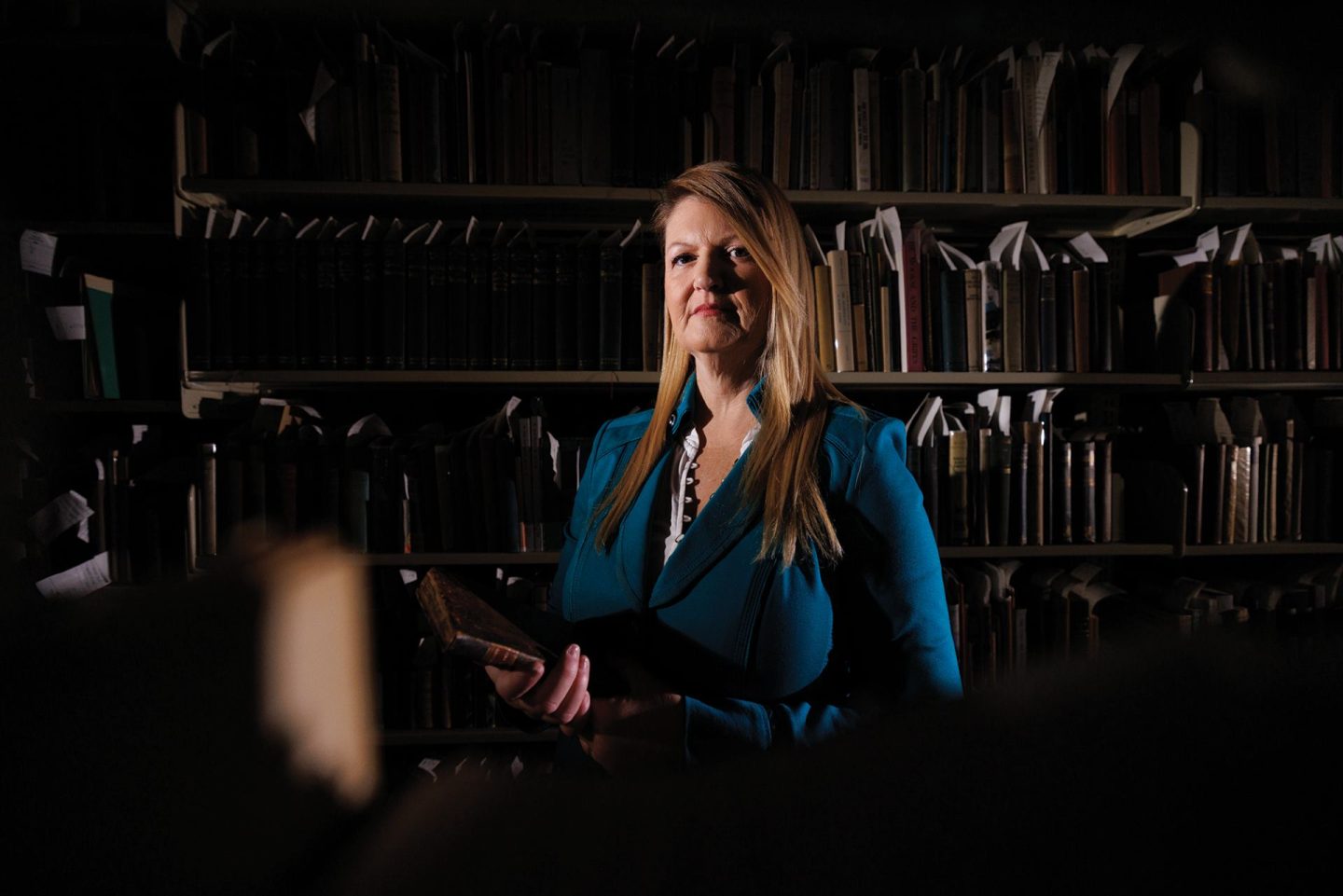Mysteries routinely arrive in Dr. Katherine Ellison’s email inbox. Sometimes they are presented by descendants of long-dead relatives who have come into possession of documents written in a secret language. Other times they come from treasure hunters who believe they have found the key to untold riches.
“They say things like, ‘I can’t tell you where this came from, but it’s going to change history,’” Ellison said. “I get a lot of that.”
An expert in the history of secret writing, Ellison has only occasionally lent her deciphering and decoding talents to such endeavors—she hasn’t uncovered any treasure yet—because her passion lies less in what is being communicated in a coded or ciphered message and more in what the practice of secret communication reveals about us.
Appears In“To me, the solutions are not all that interesting,” said Ellison, a professor in and the chair of Illinois State’s Department of English. “What interests me is the thinking that inspires secret writing and the impact that it has on us as a culture.”
Ellison first immersed herself in secret writing, also known as cryptography, in 2004 during a fellowship at the Folger Shakespeare Library in Washington, D.C., where she researched the writings of 18th century secretaries. Many of their communications were coded or ciphered.
“At that point, secretary meant manager of secrets,” Ellison explained. “Even now, I prefer the term over administrative assistant because that is what they really do: They manage office secrets.”
In the 17th and 18th centuries, literacy rates soared across Europe as education became accessible to all economic classes. It was also during this period that writing in codes and ciphers became common. Manuals were published to instruct people how to encrypt their writing.
“I was fascinated by the fact that these were not private publications only for the royalty and their courts,” Ellison said. “These were available to anyone who could read them, and they were really focused on teaching the everyday person how to cipher their correspondence.”
“Always outwardly confident and fearless, the Napoleon revealed by the cipher is broken, desperate, and emotional.”
Dr. Katherine Ellison
Although codes and ciphers are synonymous in certain contexts, there is a difference. “Codes generally have a 1-to-1 match and require a codebook. At the simplest level, A is one, B is two, and so on,” Ellison explained. “A cipher is algorithmic. There is no codebook for a cipher, so it’s much more secure. It’s a series of steps that two parties have agreed upon. Ciphers are much more complex, and that’s what interests me.”
Ciphers may hinge on letter or word placement, an indicator word or signal, or even a fold in a piece of paper. Ellison has visited libraries, archives, and special collections all over the world to examine ciphers, and she’s published on them in multiple books: A Cultural History of Early Modern English Cryptography Manuals (2016), A Material History of Medieval and Modern Ciphers: Cryptography and the History of Literacy (2017), and Secret Writing in the Long Eighteenth Century: Theories and Practices of Cryptology (2022).
An overarching theme in Ellison’s work is the connection between literacy and cryptography.
“(Secret writing) made people stop and realize that writing is a process, which we associate more with a mid- to late-20th century realization—that the teaching of writing is a process with steps,” Ellison said. “And, since it is a process, you can improve.”
Ellison has studied chains of ciphered letters that support that notion. “There’s great correspondence out there where a government figure has been sent something that is ciphered, and he’ll write back, ‘Damn it. I don’t know what you’re talking about in the third line. I tried really hard, and I’ll keep working on it, but what’s the password again?” Ellison said. “But then you’ll see more letters a few months later, and you can tell that they’ve got it figured out.
“It proves that you can get better at this kind of reading, that you can get better at any kind of reading. And you can also get better at that kind of writing.”
The type of writing most often encrypted is what you might expect. Secret writing is utilized, as Ellison stated in her 2011 book, Millions and Millions of Distinct Orders: Multimodality in Seventeenth-Century Cryptography Manuals, by “plotting assassins, paranoid politicians, and secret lovers.”
But secret writing is also utilized by everyday people, especially as an outlet to process traumatic events. A trauma studies scholar, Ellison rejects the belief that trauma is incommunicable. She’s seen it in ciphered communication.
“People shift into a very expressive mode, but they mask it in secret writing,” Ellison said. “They are finding a way to deal with traumatic situations, but they are disguising it.”
Secret writing provides a forum for vulnerability. That’s evidenced, Ellison said, in ciphered communications from Napoleon Bonaparte wherein he privately expressed wartime doubts. It’s also present in the ciphered letters of Charles I, the 17th century king of England, Scotland, and Ireland. In letters to his wife, he seems “childlike,” according to Ellison; in letters to an extramarital lover, he’s “raunchy.”
Ellison has additionally worked to build on the scholarship of Dr. John Matthews Manly and Edith Rickert. The University of Chicago scholars most well-known for producing the definitive study of Geoffrey Chaucer’s Canterbury Tales also served as codebreakers during World War I.
“They took those (codebreaking) methods back to their English department, and they began to change the way we do things in English departments,” Ellison said. “They changed the way that we read.”
Ellison is a co-editor, along with fellow Illinois State faculty member Dr. Susan Kim, of Collaborative Humanities Research and Pedagogy: The Networks of John Matthews Manly and Edith Rickert. The 2022 book was the joint effort of 10 writers and a fitting tribute to Manly and Rickert, famous for their ability to bring together teams of scholars.
Ellison and Kim previously collaborated on A Material History of Medieval and Early Modern Ciphers. Their areas of literary expertise are separated by nearly a millennium—Ellison specializes in 18th century literature, and Kim is a medievalist—but their interests overlap in the study of secret communication.
“In the history of secret writing, we see things about the study of the humanities,” Kim said. “We see ways in which visual and textual literacies are essential to the development of secret writing systems and how they’re still important in the ways we process information.”
Ellison seconds that thought, pointing to the parallels between literacy and cryptography, research and pedagogy, and more broadly, the various disciplines of the humanities.
“Humanities scholars can do incredible things when we collaborate on projects like scholars do in the sciences,” she said.
The study of secret writing goes deeper than the solutions to encrypted communications. A prime example of what can be revealed by secret writing, Ellison said, are the ciphered letters of Napoleon, who admitted to a foreign minister during the French invasion of Russia that his “calvary is in tatters” and “many horses are dying.”
“Always outwardly confident and fearless, the Napoleon revealed by the cipher is broken, desperate, and emotional,” Ellison said. “Ciphering allows him—and countless others throughout history—to express his deepest fears, his most sacred revelations, his devastating losses, and even his strongest passions, as he also often wrote to his wife, Joséphine, in a secret language.
“While our education typically focuses on documents that writers wanted wide audiences to read, we can learn much about what it means to be human from the writings that authors felt were so important they must be hidden.”


